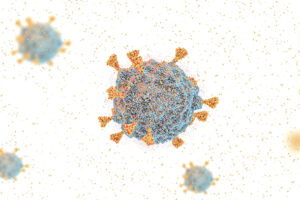Infectious Diseases
Influenza
Waning Intraseasonal Effectiveness of the Influenza Vaccine
Overview
Data suggest that immune protection from the inactivated influenza vaccine (IIV) may wane over a single season. Our featured experts discuss these data and the many considerations that inform current recommendations on the timing of influenza vaccination.
Does the effectiveness of the IIV wane during a single flu season, and, if so, what are the implications for clinical practice?
Flor M. Muñoz, MD, MSc, FAAP
|
|
“Studies of the IIV in the pediatric population have reported waning immunity as the flu season progresses. The decay of antibody levels over the course of a single season is expected, and declining antibody levels are not indicative of a complete loss of protection.”
Intraseason waning of influenza vaccine effectiveness was reported in the 2018 study by Ray et al, and these findings applied to the IIV, which is given as a shot, and not the live attenuated influenza vaccine (LAIV), which is given as a nasal spray. It is important to note that vaccination with the IIV results in the production of antibodies (immunoglobulin G and neutralizing antibodies) directed to specific virus proteins contained in the vaccine. Antibody levels in the blood usually rise in the first 2 to 4 weeks after IIV administration, peak, and then naturally decay based on their half-life. The decay of antibody levels over the course of a single season is expected, and declining antibody levels are not indicative of a complete loss of protection. Vaccination stimulates the production of cells which retain a memory of the virus antigens. Consequently, even if the antibody wanes, exposure to the virus will reactivate the immune system and induce protection. Nonetheless, the study by Ray et al estimated vaccine effectiveness, not antibody levels.
This issue of waning immunity initially began with studies in the elderly population. There is clear evidence that adaptive immunity declines with age and can dramatically reduce vaccine responses and vaccine longevity. Studies of the IIV in the pediatric population have also reported waning immunity as the flu season progresses. This is expected, given the natural antibody decay that occurs after vaccination. As clinical implications of these observations are unknown, there is no impetus or basis for changing the current vaccination recommendations.
The immune response with the LAIV is understood to be distinct from that of the IIV in several ways. The LAIV is administered in the nose and results in the local replication of an attenuated influenza virus that has been modified so that it cannot cause influenza, but it stimulates the immune system. You can get an earlier protective response with the LAIV because it results in local immunity, both directly against influenza through secretory antibodies produced in response to the vaccine virus and indirectly by the resulting mucosal inflammatory response. This nonspecific response may protect not just against influenza but also against other respiratory viruses that also come in through the nose. The LAIV also stimulates the production of serum antibodies, but its effectiveness is not associated with a specific level of serum antibody.
Mark H. Sawyer, MD, FAAP, FIDSA
|
|
“Waning immunity is just one of the subtleties of influenza that is not yet completely understood; such factors are conceptually interesting, but they are really all superseded, at this point, by the public health challenge of getting our entire eligible population of 350 million people immunized in just a few short months.”
Waning immunity is a much bigger problem in the elderly population than it is in the pediatric population. The study by Ray et al looked at the effectiveness of the IIV, and the test-negative design has both strengths and limitations. Waning immunity is just one of the subtleties of influenza that is not yet completely understood; such factors are conceptually interesting, but they are really all superseded, at this point, by the public health challenge of getting our entire eligible population of 350 million people immunized in just a few short months. Everyone needs to be vaccinated between the time of first availability of the vaccine and when influenza hits an individual community. Another area of uncertainty is whether getting vaccinated every year results in a declining response to the vaccine, or in not responding as well as getting vaccinated every other year. But, again, we do not have the luxury of trying to fine-tune vaccine delivery based on this issue unless we get stronger data indicating that it is a major problem. If we could do all of that in October, great, but it is not feasible at this time. Public health and feasibility issues trump the minor concerns about waning immunity during the season, at least based on our current data.
Tina Q. Tan, MD, FAAP, FIDSA, FPIDS
|
|
“Yes, it is understood that immunity will wane after vaccination—it wanes for every vaccine that we administer. But we really do not know what the clinical impact would be of changing the current recommendations in hopes of achieving a better alignment between the duration of immune protection and the timing of the flu season.”
I agree with Dr Sawyer on the primacy of the overarching goal in public health (ie, to immunize as many people as possible in accordance with the recommended best practices for influenza vaccination). The findings related to waning intraseasonal vaccine effectiveness are interesting; however, there are not yet sufficient data to support taking action based on these findings. For instance, moving the entire influenza vaccine program so that it starts later in the season would be unjustified in my opinion. Influenza is unpredictable, and some seasons begin earlier than others. This is an area that requires further study. Yes, it is understood that immunity will wane after vaccination—it wanes for every vaccine that we administer. But we really do not know what the clinical impact would be of changing the current recommendations in hopes of achieving a better alignment between the duration of immune protection and the timing of the flu season. The real message is to immunize early and to immunize as many individuals as soon as possible so that they are protected against influenza.
References
Centers for Disease Control and Prevention. The 2009 H1N1 pandemic: summary highlights, April 2009-April 2010. https://www.cdc.gov/h1n1flu/cdcresponse.htm. Accessed May 7, 2020.
Ferdinands JM, Fry AM, Reynolds S, et al. Intraseason waning of influenza vaccine protection: evidence from the US Influenza Vaccine Effectiveness Network, 2011-12 through 2014-15. Clin Infect Dis. 2017;64(5):544-550.
Gilca V, De Serres G, Hamelin ME, et al. Antibody persistence and response to 2010-2011 trivalent influenza vaccine one year after a single dose of 2009 AS03-adjuvanted pandemic H1N1 vaccine in children. Vaccine. 2011;30(1):35-41.
Lipsitch M, Goldstein E, Ray GT, Fireman B. Depletion-of-susceptibles bias in influenza vaccine waning studies: how to ensure robust results. Epidemiol Infect. 2019;147:e306.
O'Leary ST, Maldonado YA, Kimberlin DW. Update from the Advisory Committee on Immunization Practices. J Pediatric Infect Dis Soc. 2020;9(1):3‐5.
Ray GT, Lewis N, Klein NP, et al. Intraseason waning of influenza vaccine effectiveness. Clin Infect Dis. 2019;68(10):1623-1630.
Young B, Sadarangani S, Jiang L, Wilder-Smith A, Chen MI. Duration of influenza vaccine effectiveness: a systematic review, meta-analysis, and meta-regression of test-negative design case-control studies. J Infect Dis. 2018;217(5):731-741.













